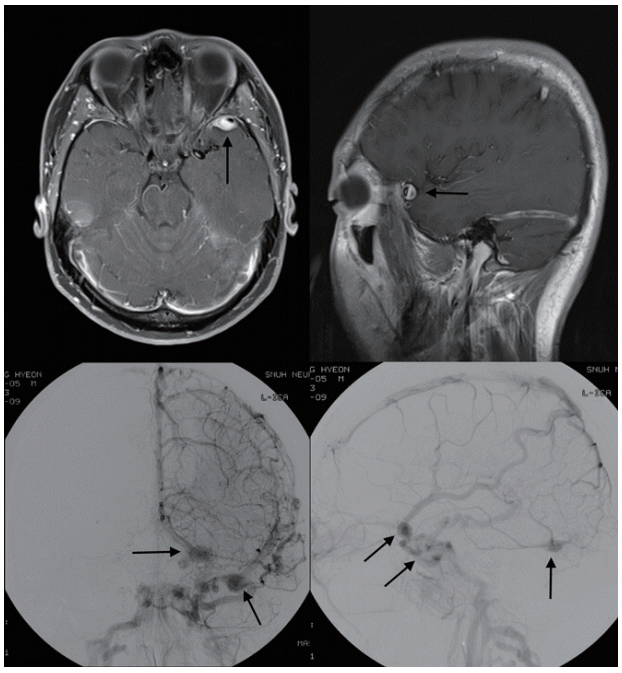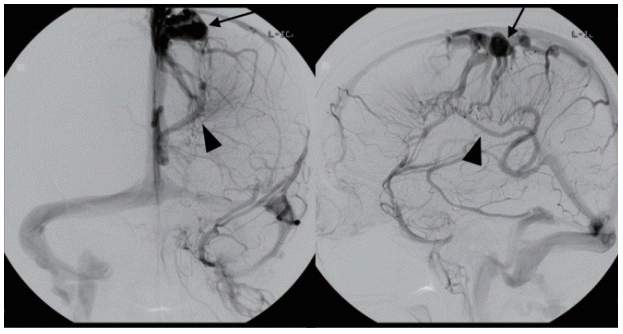1. Aydin I, Kadioğlu H, Tüzün Y, Kayaoğlu C, Takci E. The variations of Sylvian veins and cisterns in anterior circulation aneurysms. An operative study. Acta Neurochir. 138:1380–1385. 1996.

2. Boukobza M, Enjolras O, Guichard JP, Gelbert F, Herbreteau D, Reizine D, et al. Cerebral developmental venous anomalies associated with head and neck venous malformations. AJNR Am J Neuroradiol. 17:987–994. 1996.
3. Curé JK, Holden KR, Van Tassel P. Progressive venous occlusion in a neonate with Sturge-Weber syndrome: demonstration with MR venography. AJNR Am J Neuroradiol. 16:1539–1542. 1995.
4. Damiano TR, Truwit CL, Dowd CF, Symonds DL, Portela L, Dreisbach J. Posterior fossa venous angiomas with drainage through the brain stem. AJNR Am J Neuroradiol. 15:643–652. 1994.
5. Dross P, Raji MR, Dastur KJ. Cerebral varix associated with a venous angioma. AJNR Am J Neuroradil. 8:373–374. 1987.
6. Gomez DF, Mejia JA, Murcia DJ, Useche N. Isolated giant cerebral varix - a diagnostic and therapeutic challenge: a case report. Surg Neurol Int. 7(Suppl 5):S156–S159. 2016.

7. Handa J, Suda K, Sato M. Cerebral venous angioma associated with varix. Surg Neurol. 21:436–440. 1984.

8. Hoell T, Hohaus C, Beier A, Holzhausen HJ, Meisel HJ. Cortical venous aneurysm isolated cerebral varix. Interv Neuroradiol. 10:161–165. 2004.

9. Inoue T, Shima A, Hirai H, Suzuki F, Matsuda M. Trigeminal neuralgia due to an isolated cerebral varix: case report. J Neurol Surg Rep. 75:e206–209. 2014.

10. Kazumata K, Fujimoto S, Idosaka H, Kuroda S, Nunomura M, Houkin K. Multiple varices in the unilateral cerebral venous system. AJNR Am J Neuroradiol. 20:1243–1244. 1999.
11. Kelly KJ, Rockwell BH, Raji MR, Altschuler EM, Martinez AJ. Isolated cerebral intraaxial varix. AJNR Am J Neuroradiol. 16:1633–1635. 1995.
12. Kondo T, Mori Y, Kida Y, Kobayashi T, Iwakoshi T. Isolated cerebral varix developing sudden deterioration of neurological status because of thrombosis: a case report. Surg Neurol. 62:76–78. discussion 78-79. 2004.

13. Lasjaunias P, Burrows P, Planet C. Developmental venous anomalies (DVA): the so-called venous angioma. Neurosurg Rev. 9:233–242. 1986.

14. Maiuri F, Gangemi M, Iaconetta G. Giant intracranial varix associated with venous angioma and intracerebral hemorrhage. Acta neurol (Napoli). 12:231–236. 1990.
15. McCormick WF. The pathology of vascular (“arteriovenous”) malformations. J Neurosurg. 24:807–816. 1966.

16. Meyer JD, Baghai P, Latchaw RE. Cerebral varix and probable venous angioma: an unusual isolated anomaly. AJNR Am J Neuroradiol. 4:85–87. 1983.
17. Nishioka T, Kondo A, Nin K, Tashiro H, Ikai Y, Takahashi J. Solitary cerebral varix. Case report. Neurol Med Chir (Tokyo). 30(11 spect No):904–907. 1990.
18. Numaguchi Y, Nadell JM, Mizushima A, Wilensky MA. Cerebral venous angioma and a varix: a rare combination. Comput Radiol. 10:319–323. 1986.

19. Ostertun B, Solymosi L. Magnetic resonance angiography of cerebral developmental venous anomalies: its role in differential diagnosis. Neuroradiology. 35:97–104. 1993.

20. Ozturk M, Aslan S, Ceyhan Bilgici M, Idil Soylu A, Aydin K. Spontaneous thrombosis of a giant cerebral varix in a pediatric patient. Childs Nerv Syst. 33:2193–2195. 2017.

21. Park SC, Kim SK, Cho BK, Kim HJ, Kim JE, Phi JH, et al. Sinus pericranii in children: report of 16 patients and preoperative evaluation of surgical risk. J Neurosurg Pediatr. 4:536–542. 2009.

22. Pritz MB. Ruptured supratentorial arteriovenous malformations associated with venous aneurysms. Acta Neurochir (Wien). 128:150–162. 1994.

23. Roda JM, Bencosme J, Isla A, Blázquez MG. Intraventricular varix causing hemorrhage. Case report. J Neurosurg. 68:472–473. 1988.
24. Saigal G, Villalobos E. A variant of the superficial middle cerebral vein mimicking an extraaxial hematoma. AJNR Am J Neuroradiol. 24:968–970. 2003.
25. Sarwar M. Deep venous occlusion in the Sturge-Weber syndrome. Rev Interam Radiol. 2:159–161. 1977.
26. Sarwar M, McCormick WF. Intracerebral venous angioma, Case report and review. Arch Neurol. 35:323–325. 1978.
27. Sherry RG, Walker ML, Olds MV. Sinus pericranii and venous angioma in the blue-rubber bleb nevus syndrome. AJNR Am J Neuroradil. 5:832–834. 1984.
28. Shibata Y, Hyodo A, Tsuboi K, Yoshii Y, Nose T. Isolated cerebral varix with magnetic resonance imaging findings--case report. Neurol Med Chir (Tokyo). 31:156–158. 1991.
29. Sirin S, Kahraman S, Gocmen S, Erdogan E. A rare combination of a developmental venous anomaly with a varix. Case report. J Neurosurg Pediatr. 1:156–159. 2008.
30. Tan ZG, Zhou Q, Cui Y, Yi L, Ouyang Y, Jiang Y. Extra-axial isolated cerebral varix misdiagnosed as convexity meningioma: a case report and review of literatures. Medicine (Baltimore). 95:e4047. 2016.
31. Tanju S, Ustuner E, Deda H, Erden I. Cerebral varix simulating a meningioma: use of 3D magnetic resonance venography for diagnosis. Curr Probl Diagn Radiol. 35:258–260. 2006.

32. Tanohata K, Machara T, Noda M, Katoh H. Isolated cerebral varix of superficial cortical vein: CT demonstration. J Comput Assit Tomogr. 10:1073–1074. 1986.
33. Tyson GW, Jane JA, Strachan WE. Intracerebral hemorrhage due to ruptured venous aneurysm. Report of two cases. J Neurosurg. 49:739–743. 1978.
34. Uchino A, Hasuo K, Matsumoto S, Ikezaki K, Masuda K. Varix occurring with cerebral venous angioma: a case report and review of the literature. Neuroradiology. 37:29–31. 1995.

35. Vattoth S, Purkayastha S, Jayadevan ER, Gupta AK. Bilateral cerebral venous angioma associated with varices: a case report and review of the literature. AJNR Am J Neuroradiol. 26:2320–2322. 2005.
36. ViñUela F, Drake CG, Fox AJ, Pelz DM. Giant intracranial varices secondary to high-flow arteriovenous fistulae. J Neurosurg. 66:198–203. 1987.

37. Wilms G, Demaerel P, Robberecht W, Plets C, Goffin J, Carton H, et al. Coincidence of developmental venous anomalies and other brain lesions: a clinical study. Eur Radiol. 5:495–500. 1995.





 PDF
PDF Citation
Citation Print
Print





 XML Download
XML Download